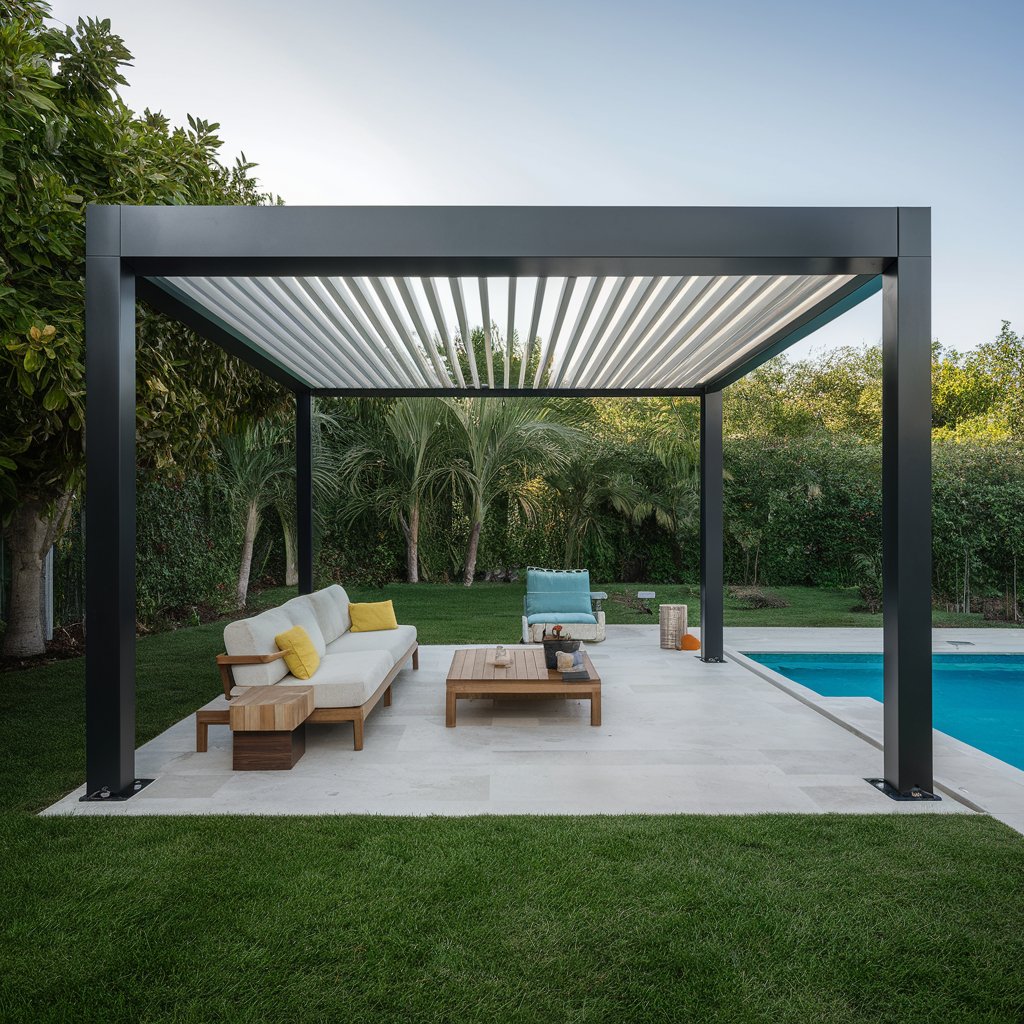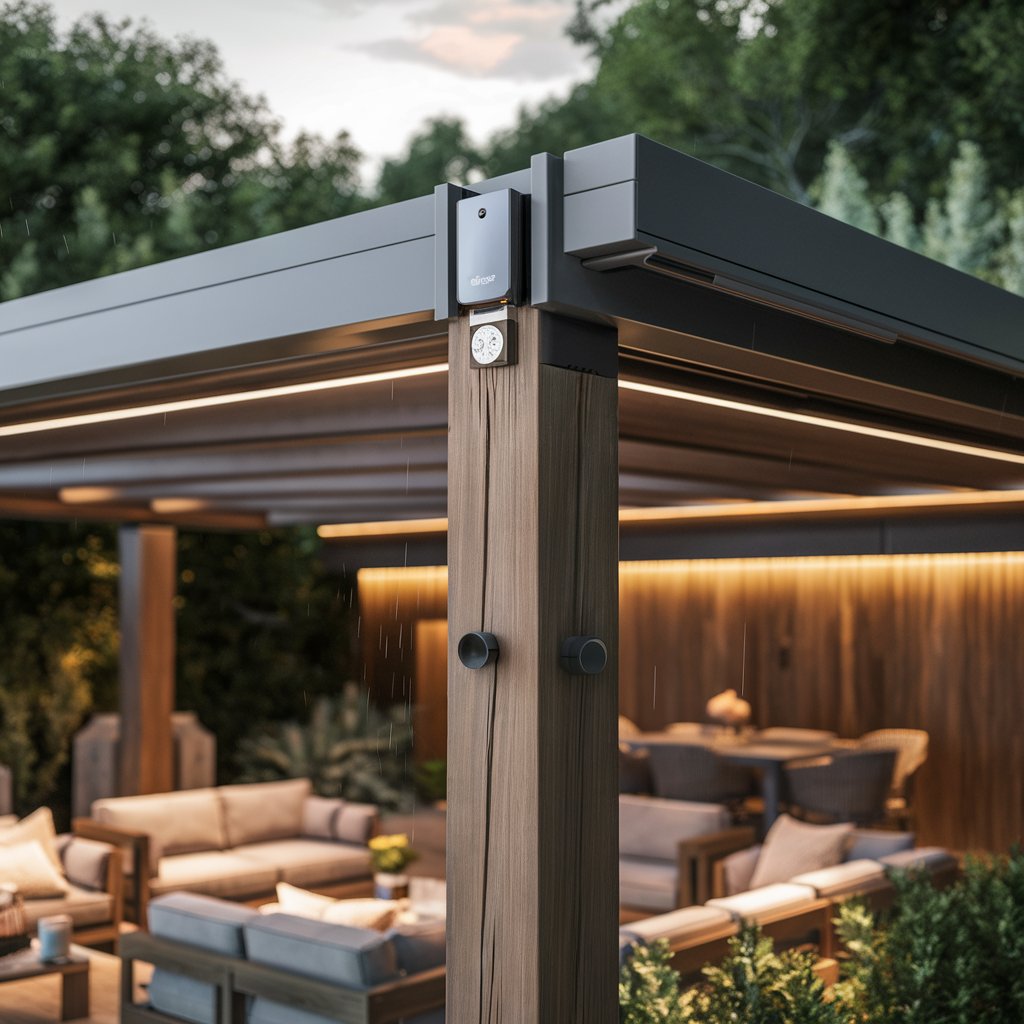Pergolas have become a staple in modern landscaping, offering a blend of beauty and functionality that transforms ordinary gardens into luxurious outdoor retreats. Whether you’re looking to create a serene space for relaxation or a lively area for entertaining guests, integrating a pergola into your landscape design can significantly enhance your outdoor living experience. In this comprehensive guide, we will explore various aspects of pergola landscaping, from design principles and material selection to plant integration and maintenance tips.
Understanding Pergolas
A pergola is an outdoor structure consisting of vertical posts or pillars that support a grid of beams and rafters, forming an open roof. This open-roof design can be left uncovered or adorned with climbing plants and fabrics to provide shade and aesthetic appeal. Pergolas can be freestanding or attached to a building, making them versatile for various landscaping needs.
Benefits of Pergola Landscaping
- Enhanced Aesthetic Appeal: Pergolas add architectural interest and elegance to your garden, creating a focal point that enhances the overall landscape design.
- Functional Outdoor Space: They provide a designated area for outdoor activities such as dining, lounging, or entertaining, effectively extending your living space.
- Shade and Comfort: When covered with plants, fabric, or retractable canopies, pergolas offer much-needed shade, making your outdoor space more comfortable during hot weather.
- Increased Property Value: A well-designed pergola can boost your property’s value by adding an attractive and functional feature to your garden.
- Versatility: Pergolas can be customized to fit various styles, sizes, and functions, making them suitable for different landscape designs and preferences.
Designing Your Pergola Landscape
Designing a pergola landscape involves careful planning and consideration of various elements to ensure a harmonious and functional outdoor space. Here are some key design principles to guide you:
Site Selection
Choosing the right location for your pergola is crucial for maximizing its functionality and aesthetic appeal. Consider the following factors when selecting a site:
- Sun Exposure: Determine the amount of sunlight the area receives throughout the day. Choose a location that offers the desired balance of sun and shade.
- Views and Privacy: Position your pergola to take advantage of scenic views while providing privacy from neighboring properties.
- Accessibility: Ensure easy access to and from the pergola, especially if it will be used for dining or entertaining.
- Landscape Integration: Consider how the pergola will fit into the overall landscape design, including the proximity to other garden features such as patios, pools, or gardens.
Style and Design
The style and design of your pergola should complement the architecture of your home and the overall landscape theme. Here are some popular pergola styles to consider:
- Traditional: Characterized by classic columns and intricate details, traditional pergolas often feature wood or stone materials.
- Modern: Sleek lines, minimalistic design, and materials like metal or composite are hallmarks of modern pergolas.
- Rustic: Using natural materials like reclaimed wood or bamboo, rustic pergolas blend seamlessly with natural surroundings.
- Mediterranean: Featuring arched beams, terracotta roofing, and decorative elements, Mediterranean pergolas evoke a warm, exotic ambiance.
Material Selection
Choosing the right materials for your pergola is essential for durability, maintenance, and aesthetic appeal. Common materials include:
- Wood: Popular for its natural beauty and versatility, wood can be stained or painted to match your desired style. Cedar, redwood, and teak are excellent choices for their durability and resistance to decay.
- Metal: Aluminum and steel offer a sleek, modern look and are highly durable. Metal pergolas require minimal maintenance and can be powder-coated in various colors.
- Vinyl: Vinyl pergolas are low-maintenance and resistant to rot, insects, and weather damage. They are available in various colors and styles to suit different design preferences.
- Composite: Combining wood fibers and plastic, composite materials offer the natural look of wood with enhanced durability and minimal maintenance.
Structural Elements
Incorporating various structural elements can enhance the functionality and visual appeal of your pergola:
- Columns and Beams: Choose columns and beams that complement your pergola’s style. Options include square or round columns, and beams with decorative ends or simple, clean lines.
- Roofing: Pergola roofs can be open or covered with various materials such as fabric, polycarbonate panels, or retractable canopies. Climbing plants can also create a natural canopy.
- Flooring: Select flooring materials that complement the pergola and surrounding landscape. Options include natural stone, pavers, wood decking, or gravel.
- Lighting: Integrate lighting to enhance the ambiance and functionality of your pergola. Options include string lights, pendant lights, lanterns, or built-in LED fixtures.
Plant Integration in Pergola Landscaping
Integrating plants into your pergola landscape is a key aspect of creating a lush, inviting outdoor space. Plants can provide shade, privacy, and aesthetic beauty, enhancing the overall ambiance of your pergola.
Climbing Plants
Climbing plants are ideal for pergolas, as they can cover the structure with greenery and flowers, creating a natural canopy. Popular climbing plants for pergolas include:
- Wisteria: Known for its cascading clusters of fragrant flowers, wisteria adds a romantic touch to any pergola. Ensure it has sturdy support, as it can become heavy when mature.
- Clematis: With its vibrant, star-shaped flowers, clematis is a popular choice for adding color and texture to pergolas. It thrives in well-drained soil and partial shade.
- Honeysuckle: This fast-growing vine produces fragrant, tubular flowers that attract hummingbirds and butterflies. It’s perfect for adding a sweet scent to your pergola.
- Roses: Climbing roses add classic beauty and fragrance to pergolas. They require regular pruning and support to grow healthily.
- Grapevines: Ideal for creating a lush, green canopy, grapevines also provide the added benefit of producing edible fruit. They thrive in sunny locations and well-drained soil.
Container Gardening
Incorporating container gardens around your pergola adds color and variety to the landscape. Use containers of different sizes and shapes to create visual interest. Consider the following plants for container gardening:
- Herbs: Basil, rosemary, thyme, and mint are not only useful in the kitchen but also add fragrance and texture to your pergola area.
- Annuals and Perennials: Petunias, geraniums, marigolds, and hostas are excellent choices for adding seasonal color to your containers.
- Ornamental Grasses: Grasses like fountain grass, blue fescue, and Japanese forest grass add texture and movement to your container garden.
- Succulents: Low-maintenance succulents like aloe, echeveria, and sedum thrive in containers and add a modern, sculptural element to the landscape.
Ground Cover and Borders
Enhance the base of your pergola with ground cover plants and border plantings to create a cohesive and lush landscape:
- Ground Cover Plants: Low-growing plants like creeping thyme, sedum, and ajuga can cover the ground around your pergola, adding greenery and reducing weed growth.
- Borders and Edging: Planting borders of flowering plants, shrubs, or ornamental grasses around the perimeter of your pergola can define the space and add visual interest. Consider using lavender, boxwood, or ornamental grasses for attractive borders.
Vertical Gardens
Vertical gardens are a creative way to incorporate more greenery into your pergola landscape. Use wall-mounted planters, trellises, or hanging baskets to create a vertical garden:
- Wall-Mounted Planters: Attach planters to the sides of your pergola or nearby walls to grow herbs, succulents, or flowering plants.
- Trellises: Install trellises along the pergola columns for climbing plants like jasmine, ivy, or climbing roses.
- Hanging Baskets: Hang baskets filled with trailing plants like petunias, fuchsias, or ivy from the pergola beams to add color and greenery at different heights.
Enhancing Pergola Functionality
Beyond aesthetic appeal, enhancing the functionality of your pergola can make it a more versatile and enjoyable outdoor space. Here are some ideas to consider:
Outdoor Furniture
Selecting the right outdoor furniture is crucial for creating a comfortable and inviting pergola area. Consider the following tips:
- Durable Materials: Choose furniture made from weather-resistant materials like teak, aluminum, or synthetic wicker to ensure longevity.
- Comfort: Invest in comfortable seating with cushions made from outdoor fabrics that resist fading and mildew.
- Layout: Arrange furniture to facilitate conversation and easy movement. Consider modular furniture for flexibility in configuring different seating arrangements.
Outdoor Kitchen and Dining
Incorporating an outdoor kitchen or dining area under your pergola can transform it into a hub for entertaining and family gatherings. Essential elements include:
- Grill or Barbecue: A built-in or portable grill is essential for outdoor cooking. Ensure there is adequate ventilation and safety measures in place.
- Counter Space: Provide ample countertop space for food preparation and serving. Consider durable materials like granite, stainless steel, or concrete.
- Storage: Include cabinets or shelving for storing cooking utensils, dishes, and supplies.
- Dining Area: Choose a dining table and chairs that fit comfortably under your pergola. Consider extending the dining area with a built-in bench or additional seating.
Heating and Cooling
Enhance the comfort of your pergola area by incorporating heating and cooling solutions:
- Outdoor Heaters: Portable or wall-mounted heaters can extend the usability of your pergola during cooler months.
- Fire Pit: A fire pit or fireplace adds warmth and ambiance, making your pergola a cozy gathering spot.
- Ceiling Fans: Install ceiling fans to provide a cooling breeze during hot weather.
- Misting Systems: Misting systems can help keep the area cool and comfortable on hot days.
Entertainment
Transform your pergola into an entertainment hub with the following features:
- Outdoor Speakers: Install weather-resistant speakers to enjoy music while relaxing or entertaining.
- Television: Consider adding an outdoor-rated television for watching movies, sports, or other entertainment.
- Lighting: Incorporate various lighting options, such as string lights, lanterns, or LED fixtures, to create the desired ambiance for different occasions.
Privacy and Shade
Creating a sense of privacy and shade is essential for making your pergola a comfortable and inviting space:
- Curtains and Drapes: Outdoor curtains or drapes can be drawn to provide privacy and shade when needed. Choose weather-resistant fabrics that complement your pergola’s design.
- Privacy Screens: Install lattice panels, bamboo screens, or trellises with climbing plants to create natural privacy screens.
- Shade Sails: Use shade sails or retractable canopies to provide adjustable shade. These can be installed in various configurations to suit your needs.
Maintaining Your Pergola Landscape
Regular maintenance is essential for keeping your pergola landscape looking beautiful and functioning well. Here are some maintenance tips:
Cleaning and Upkeep
- Regular Cleaning: Clean your pergola structure regularly to remove dirt, dust, and debris. Use a mild detergent and water for most materials. For wood, consider using a pressure washer with care.
- Inspect for Damage: Periodically inspect your pergola for signs of damage, such as cracks, rot, or rust. Address any issues promptly to prevent further deterioration.
- Plant Care: Maintain climbing plants and container gardens by watering, pruning, and fertilizing as needed. Ensure that plants are healthy and free from pests and diseases.
Seasonal Maintenance
- Winter Preparation: For regions with harsh winters, prepare your pergola by removing or securing any removable elements, such as fabric canopies or cushions. Protect wooden pergolas with a weatherproof sealant.
- Spring Refresh: In spring, clean and refresh your pergola landscape by trimming plants, adding new mulch, and inspecting the structure for any winter damage.
Long-Term Care
- Wood Treatment: For wooden pergolas, apply a stain or sealant every few years to protect against moisture and UV damage.
- Metal Maintenance: Metal pergolas may require periodic painting or coating to prevent rust and corrosion.
- Vinyl and Composite Care: These materials typically require minimal maintenance, but regular cleaning will keep them looking their best.
Conclusion
Pergola landscaping offers endless possibilities for creating a beautiful, functional, and inviting outdoor space. By carefully selecting the location, style, materials, and plants, you can design a pergola that complements your home and enhances your garden. Integrating features like outdoor furniture, kitchens, lighting, and entertainment options can further elevate the functionality and enjoyment of your pergola. With regular maintenance and care, your pergola landscape will remain a cherished part of your outdoor living space for years to come.
4o


